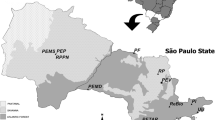Summary
We measured the “distance dialects” in the dance languages of three honey bee species in Thailand (Apis florea, A. cerana, and A. dorsata), and used these dialects to examine the hypothesis that a colony's dialect is adaptively “tuned” to enhance efficiency of communication over the distances that its foragers typically fly. in contrast to previous interspecific comparisons in Sri Lanka (Lindauer 1956; Punchihewa et al. 1985), we found no striking dialect differences among the Asian bees in Thailand. The adaptive tuning hypothesis predicts that the foraging ranges of the three species should also be similar, but comparisons of colonial foraging range using the “forage mapping” technique (Visscher and Seeley 1982) actually revealed marked differences. This raises the possibility that the link between ecology and distance code is more subtle than previously supposed, if a link exists at all.
Similar content being viewed by others
References
Boch R (1957) Rassenmäßige Unterschiede bei den Tänzen der Honigbiene (Apis mellifica L.). Z Vergl Physiol 40:289–320
Dyer FC (1985a) Mechanisms of dance orientation in the Asian honey bee Apis forea L. J Comp Physiol 157:183–198
Dyer FC (1985b) Nocturnal orientation by the Asian honey bee, Apis dorsata. Anim Behav 33:769–774
Dyer FC (1987) New perspectives on the dance orientation of the Asian honeybees. In: Menzel R, Mercer A (eds) Neurobiology and behavior of honeybees. Springer, Berlin Heidelberg New York, pp 54–65
Dyer FC, Seeley TD (1987) Interspecific comparisons of endothermy in honey-bees (Apis): deviations from the expected size-related patterns. J Exp Biol 127:1–26
Dyer FC, Seeley TD (1991) Nesting behavior and the evolution of worker tempo in four species of honey bees (Apis). Ecology (in press)
Esch H (1978) On the accuracy of the distance message in the dances of honey bees. J Comp Physiol 123:339–347
Frankie GW, Baker HG, Opler PA (1974) Comparative phenological studies of trees in tropical wet and dry forests in the lowlands of Costa Rica. J Ecol 62:881–913
Frisch K von (1967) The dance language and orientation of bees. Harvard University Press, Cambridge
Frisch K von, Jander R (1957) Über den Schwänzeltanz der Bienen. Z Vergl Physiol 40:239–263
Gould JL (1982) Why do honey bees have dialects? Behav Ecol Sociobiol 10:53–56
Janzen DH (1967) Synchronization of sexual reproduction of trees within the dry season in Central America. Evolution 21:620–637
Koeniger N, Vorwohl G (1979) Competition for food among four sympatric species of Apini in Sri Lanka (Apis dorsata, Apis cerana, Apis florea, and Trigona iridipennis). J Apic Res 18:95–109
Lindauer M (1956) Über die Verständigung bei indischen Bienen. Z Vergl Physiol 38:521–557
Punchihewa RWK, Koeniger N, Kevan PG, Gadawski RM (1985) Observations on the dance communication and natural foraging ranges of Apis cerana, Apis dorsata, and Apis florea in Sri Lanka. J Apic Res 24:168–175
Ruttner F (1988) Biogeography and taxonomy of honeybees. Springer, Berlin Heidelberg New York
Seeley TD (1985) Honeybee ecology. A study of adaptation in social life. Princeton University Press, Princeton
Seeley TD (1989) Social foraging in honey bees: how nectar foragers assess their colony's nutritional status. Behav Ecol Sociobiol 24:181–199
Seeley TD, Levien RA (1987) Social foraging by honeybees: how a colony tracks rich sources of nectar. In: Menzel R, Mercer A (eds) Neurobiology and behavior of honeybees. Springer, Berlin Heidelberg New York, pp 38–53
Seeley TD, Seeley RH, Akratanakul P (1982) Colony defense strategies of the honeybees in Thailand. Ecol Monogr 52:43–63
Sokal RR, Rohlf FJ (1981) Biometry, 2nd edn. Freeman, San Francisco
Stehe W (1954) Gibt es “Dialekte” der Bienensprache? Dissertation, University of Munich
Towne WF (1985) Acoustic and visual cues in the dances of four honeybee species. Behav Ecol Sociobiol 16:185–187
Towne WF, Gould JL (1988) The spatial precision of the honey bees' dance communication. J Insect Behav 1:129–155
Visscher PK, Seeley TD (1982) Foraging strategy of honeybee colonies in a temperate deciduous forest. Ecology 63:1790–1801
Wenner AM (1962) Sound production during the waggle dance of the honey bee. Anim Behav 10:79–95
Author information
Authors and Affiliations
Additional information
Offprint requests to: F.C. Dyer
Rights and permissions
About this article
Cite this article
Dyer, F.C., Seeley, T.D. Dance dialects and foraging range in three Asian honey bee species. Behav Ecol Sociobiol 28, 227–233 (1991). https://doi.org/10.1007/BF00175094
Received:
Accepted:
Issue Date:
DOI: https://doi.org/10.1007/BF00175094




